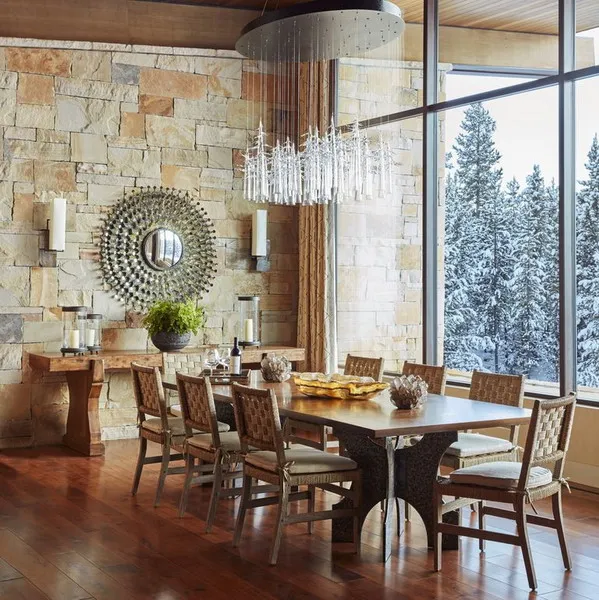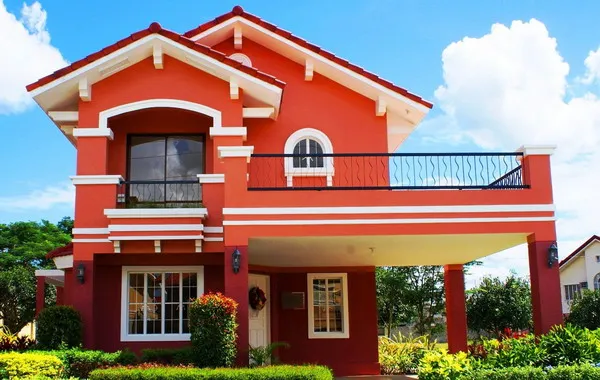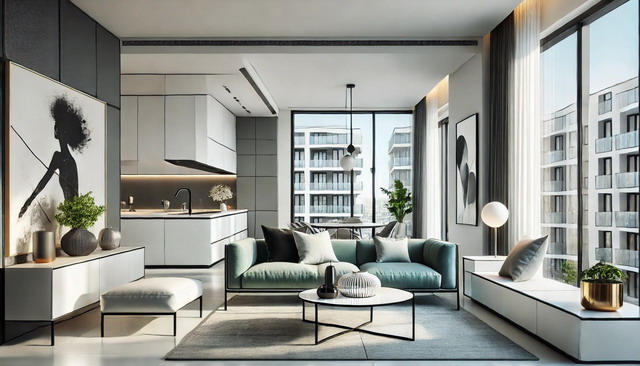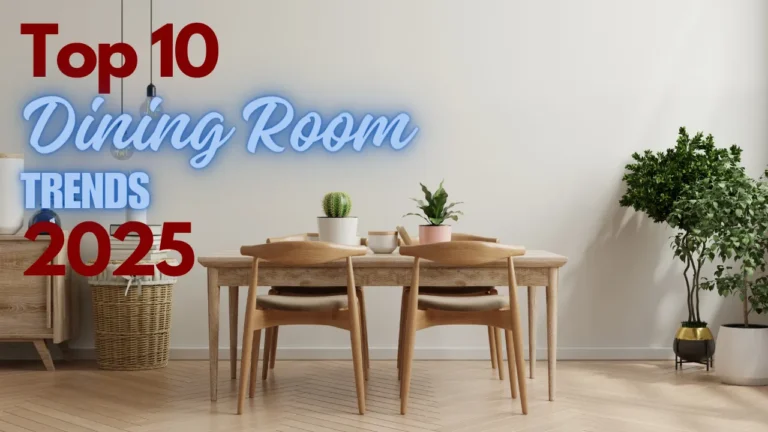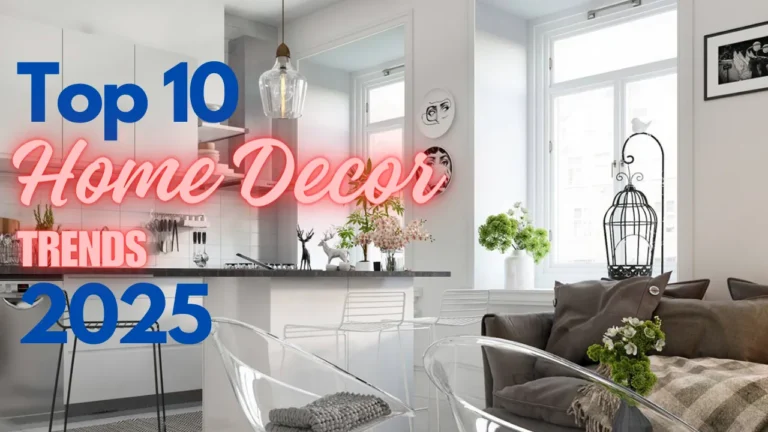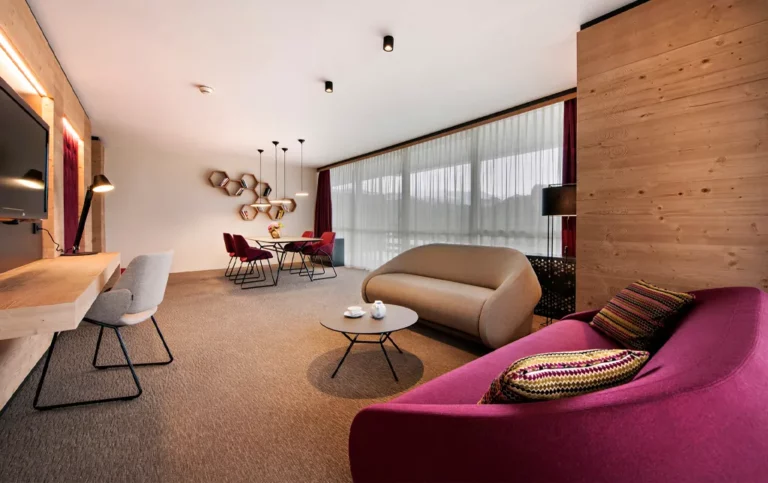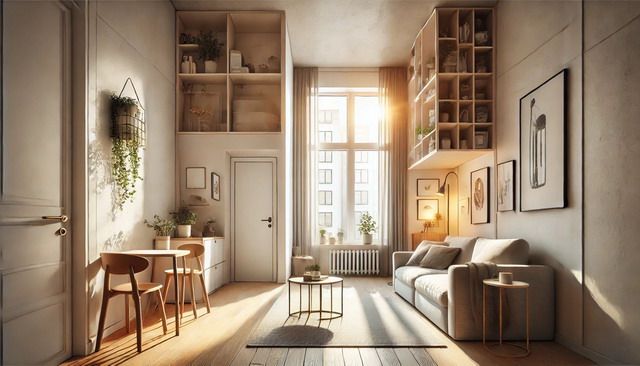Tile Trends 2025: Discover the Latest Designs for a Stylish Home
Last Updated on September 14, 2024 by Mutiara
As we step into 2025, the world of interior design is experiencing a dynamic evolution, with tiles at the forefront of this transformation. Once viewed primarily as a functional necessity, tiles are now becoming central elements of design, celebrated for their versatility, durability, and ability to make bold statements in both residential and commercial spaces. From eco-friendly materials to smart technology, the tile trends for 2025 offer a perfect blend of innovation and style, reflecting a growing demand for sustainable living and personalized aesthetics.
This year’s trends are about more than just aesthetics—they highlight a shift towards sustainability, functionality, and the integration of modern technology into everyday living. Designers and homeowners are increasingly focused on using tiles that not only look stunning but also contribute to healthier, more energy-efficient homes. Bold colors, intricate patterns, innovative shapes, and tactile textures are paving the way for a more expressive approach to interior and exterior design, while the emphasis on durability and ease of maintenance ensures these tiles are as practical as they are beautiful.
Whether you’re planning to update your kitchen, revamp your bathroom, or enhance your outdoor living space, the tile trends of 2025 offer endless possibilities for creativity and customization. This article explores the top tile trends that are set to dominate in the coming year, helping you stay ahead of the curve in creating spaces that are both stylish and sustainable.
1. Popular Tile Patterns for 2025
As we step into 2025, the world of interior design is embracing a renaissance of creativity, particularly in the realm of tile patterns. Tiles are no longer just functional elements; they have become canvases for artistic expression, transforming spaces with their patterns, textures, and colors. Let’s explore the popular tile patterns set to dominate homes and commercial spaces this year.
Geometric Patterns Steal the Spotlight
Geometric patterns are taking center stage in 2025, offering a modern twist to traditional design. Think bold hexagons, intricate chevrons, and dynamic diamond shapes. These patterns bring a sense of order and symmetry while adding visual intrigue to any room. Hexagonal tiles, for instance, can create a honeycomb effect on floors and walls, providing depth and a contemporary flair. The key is to balance complexity with simplicity—using geometric tiles in neutral tones can make a space feel both sophisticated and approachable.
Organic and Nature-Inspired Designs
In contrast to the precision of geometric patterns, organic designs are also making waves. These patterns draw inspiration from nature, featuring fluid lines, botanical motifs, and earthy textures. Tiles that mimic the veins of leaves, the flow of water, or the contours of natural landscapes are becoming increasingly popular. This trend aligns with the broader movement towards biophilic design, which seeks to incorporate natural elements into interior spaces to enhance well-being and connection to the environment.
The Revival of Intricate Mosaics
Mosaic tiles are experiencing a revival, bringing a touch of timeless elegance to modern interiors. Intricate mosaics composed of small, colored pieces can transform a simple surface into a work of art. In 2025, expect to see mosaics not just in traditional settings but also in contemporary spaces, where they add texture and complexity. From kitchen backsplashes adorned with Mediterranean-inspired patterns to bathroom floors featuring abstract designs, mosaics offer endless possibilities for personalization.
Large-Format Tiles for a Seamless Look
Large-format tiles are becoming a staple in 2025’s design playbook. These oversized tiles reduce the number of grout lines, creating a seamless and expansive look that can make small spaces appear larger. Whether used on floors or walls, large-format tiles contribute to a minimalist aesthetic that emphasizes clean lines and open spaces. They are particularly popular in neutral shades like greys, beiges, and whites, which enhance their ability to blend effortlessly into various design schemes.
Mix and Match: The Art of Combining Patterns
An exciting trend for 2025 is the deliberate mixing and matching of different tile patterns. This approach breaks away from the uniformity of single-pattern designs, allowing for a more eclectic and personalized space. Designers are combining geometric floor tiles with organic wall patterns or pairing bold mosaics with subtle textures to create a dynamic visual experience. The key to mastering this trend is balance—selecting patterns that complement rather than compete with each other.
Textured Tiles Add a Tactile Dimension
Beyond visual patterns, textured tiles are gaining traction for the tactile dimension they bring to interiors. Three-dimensional tiles with raised patterns or carved designs can add depth and interest to walls and floors. Textured tiles that mimic natural materials like stone, wood, or fabric provide the aesthetic appeal of these materials without the associated maintenance challenges.
Color Play: From Subtle to Vibrant
Color is an integral part of tile patterns in 2025. While neutral tones remain popular for their versatility, there’s a growing embrace of vibrant colors and bold contrasts. Deep blues, rich greens, and warm terracottas are being used to make statements in kitchens, bathrooms, and entryways. These colors can be incorporated through solid-colored tiles or as part of intricate patterns, offering a way to inject personality and energy into a space.
In summary, the popular tile patterns for 2025 are all about self-expression and innovation. Whether you gravitate towards the structured appeal of geometric designs, the soothing allure of organic patterns, or the artistic flair of mosaics, there’s a trend to suit every taste. As tiles continue to evolve from mere functional elements to focal points of design, embracing these patterns can transform your space into a reflection of the latest in interior style.
2. Eco-Friendly Tile Materials for 2025
Sustainability is no longer a buzzword—it’s a guiding principle in design and construction, and 2025 is shaping up to be a pivotal year for eco-friendly tile materials. Homeowners and designers alike are seeking options that not only look good but also reduce environmental impact. The tile industry is responding with innovative materials and production methods that prioritize sustainability without compromising on style or durability.
Recycled Tiles: Transforming Waste into Beauty
One of the most significant strides in eco-friendly tiles is the use of recycled materials. Recycled glass tiles, for example, are made from post-consumer and industrial glass waste. These tiles offer a brilliant shine and a unique aesthetic, available in a myriad of colors and finishes. Similarly, some manufacturers are producing tiles from recycled ceramic and porcelain, reducing the need for new raw materials and minimizing landfill waste.
Eco-Friendly Porcelain: Durable and Sustainable
Porcelain tiles have long been favored for their durability and low maintenance, and now they’re getting an eco-friendly upgrade. Producers are adopting more sustainable manufacturing processes, such as using energy-efficient kilns and incorporating recycled content into their products. Additionally, sourcing local materials reduces transportation emissions, further decreasing the environmental footprint of these tiles.
Low-Impact Production Methods
Advancements in technology have enabled tile manufacturers to adopt low-impact production methods. Water used in the manufacturing process is increasingly being recycled, and waste heat from kilns is repurposed to reduce energy consumption. Digital printing technology allows for precise designs without the need for excess dyes or glazes, which can be harmful to the environment. These practices contribute to a significant reduction in greenhouse gas emissions and resource usage.
Natural Stone Alternatives
While natural stone tiles like marble and granite are beautiful, quarrying these materials can be environmentally damaging. In 2025, we see a surge in the popularity of tiles that mimic the appearance of natural stone without the associated ecological cost. Engineered stone tiles use a combination of recycled stone dust and eco-friendly resins to create a product that is visually identical to natural stone but far more sustainable.
Biodegradable and Renewable Materials
Tiles made from biodegradable and rapidly renewable materials are making a splash. Cork and bamboo tiles are excellent examples; both materials are harvested without killing the plant, allowing for continuous growth. Cork tiles offer excellent insulation properties and a soft underfoot feel, making them ideal for living spaces and bedrooms. Bamboo tiles provide a sleek, modern look and are incredibly durable, suitable for high-traffic areas.
Low-VOC and Non-Toxic Options
Indoor air quality is a crucial aspect of sustainable living. Tiles that emit low levels of Volatile Organic Compounds (VOCs) contribute to healthier indoor environments. Eco-friendly tiles often feature natural sealants and adhesives that are non-toxic and free from harmful chemicals. This is particularly important for homes with children, pets, or individuals with allergies and respiratory issues.
Embracing Cradle-to-Cradle Principles
The cradle-to-cradle approach is influencing tile production in 2025. This principle focuses on creating products that can be fully reclaimed or re-used at the end of their life cycle, thereby eliminating waste. Some tiles are designed to be easily removed and repurposed, while others are made from materials that can be recycled indefinitely without loss of quality. This holistic view of sustainability ensures that tiles remain environmentally friendly from production to disposal.
Certifications and Eco-Labels
Consumers are increasingly looking for verification of a product’s sustainability claims. Eco-friendly tiles often come with certifications such as LEED (Leadership in Energy and Environmental Design), GreenGuard, or certifications from the Forest Stewardship Council (FSC) for wood-based products. These labels provide assurance that the tiles meet specific environmental standards, covering aspects like material sourcing, energy use, and emissions.
Innovative Materials: From Agro-Waste to Algae
Innovation is pushing the boundaries of what constitutes tile material. Some manufacturers are experimenting with agro-waste, such as rice husks or nut shells, incorporating them into tile production. Others are exploring the use of fast-growing algae as a raw material. These unconventional sources offer the dual benefit of utilizing waste products and reducing reliance on traditional, resource-intensive materials.
In conclusion, eco-friendly tile materials for 2025 are at the forefront of sustainable design. With a range of options from recycled and renewable materials to low-impact manufacturing and cradle-to-cradle principles, it’s easier than ever to make environmentally conscious choices. These tiles not only lessen the ecological footprint of a space but also contribute to healthier indoor environments, aligning style with sustainability in the most harmonious way.
3. Smart Tile Technology: The Future of Flooring
As we venture further into the future of design, technology continues to transform the way we live, and flooring is no exception. In 2025, the integration of smart technology into tiles is emerging as a groundbreaking trend that combines aesthetics with functionality. These innovations are not just about convenience—they are about creating homes that respond to the needs of the occupants in real-time, enhancing comfort, safety, and efficiency.
Heated Tiles for Ultimate Comfort
One of the most popular applications of smart tile technology is the introduction of heated tiles. No longer limited to high-end bathrooms or luxury hotels, heated tile flooring is becoming more accessible to homeowners. These tiles incorporate built-in heating systems that can be adjusted remotely via smartphone apps or integrated with a smart home system. Imagine stepping onto warm floors on a cold winter morning, with the temperature automatically adjusted to your preferences.
These heated tiles are also energy-efficient, often using less power than traditional heating systems. Some models even have programmable settings, allowing users to control heating schedules based on their daily routines, reducing unnecessary energy consumption.
Lighting-Integrated Tiles for Enhanced Ambience
Smart tiles with integrated LED lighting are another exciting innovation. These tiles are not only functional but also provide aesthetic appeal by enhancing the ambiance of a space. Whether used to illuminate pathways, stairs, or bathroom floors, lighting tiles add an element of luxury and safety. In some models, the lights can be programmed to change colors, offering a dynamic visual experience that complements the interior design.
This feature can also serve a practical purpose, particularly in hallways or outdoor areas. Motion sensors can trigger the lights when someone enters a room, ensuring safe navigation at night without the need to turn on overhead lighting. These smart tiles are especially beneficial for elderly or disabled individuals who require additional safety features in their homes.
Energy-Harvesting Tiles: Powering the Future
A revolutionary concept in 2025’s smart tile technology is energy-harvesting tiles. These tiles capture kinetic energy generated by foot traffic and convert it into electricity. Ideal for high-traffic areas like shopping malls, public spaces, or busy households, these tiles can power small devices or feed into the grid, making them a green solution for energy-conscious consumers.
While still in its early stages, the potential of energy-harvesting tiles is immense. As the technology evolves, we could see homes and commercial spaces becoming increasingly self-sufficient in terms of energy, with tiles contributing to the reduction of carbon footprints. This innovation aligns perfectly with the growing demand for sustainable, eco-friendly building practices.
Self-Cleaning Tiles: Convenience at Its Best
Smart technology is also entering the realm of hygiene with self-cleaning tiles. These tiles are coated with special nanomaterials that break down dirt and bacteria when exposed to light, keeping the surface clean and sanitized with minimal effort. Self-cleaning tiles are especially popular in kitchens and bathrooms, where hygiene is a top priority.
The convenience of these tiles cannot be overstated, as they significantly reduce the need for regular cleaning and maintenance. For busy homeowners, this innovation offers peace of mind, knowing that their floors are constantly being cleaned without the use of harsh chemicals or labor-intensive scrubbing.
Health Monitoring Tiles
In line with the trend of smart homes geared towards health and well-being, some companies are developing tiles that monitor the health of individuals. These tiles can track movement patterns, detect falls, and even monitor vital signs such as heart rate and temperature. When integrated with a smart home system, these tiles can send alerts to caregivers or medical professionals, making them particularly useful for elderly or vulnerable populations.
These innovations in smart tile technology are pushing the boundaries of what we expect from flooring. As we look to the future, it’s clear that tiles are no longer just a static design element—they are becoming an active participant in making our homes more comfortable, efficient, and safe.
4. Tile Colors and Finishes for 2025
Color and finish play a critical role in tile design, setting the mood and tone of a space. In 2025, we see an exciting evolution in tile color palettes and finishes, driven by the desire for individuality and expression in interior design. The trend is moving beyond neutral shades to embrace bold, vibrant hues and luxurious finishes, while still catering to those who prefer subtlety and elegance.
Earthy Tones and Natural Palettes
A key trend in 2025 is the resurgence of earthy tones. Colors like terracotta, sage green, deep browns, and soft beiges are making a comeback as homeowners and designers lean into biophilic design principles. These natural colors bring warmth and a sense of calm, making them perfect for creating serene environments. Earthy tones also pair beautifully with organic textures and materials like wood and stone, which are increasingly popular in interior design.
Bold Colors: From Jewel Tones to Deep Blues
For those who are more adventurous with color, 2025 offers plenty of options. Jewel tones such as emerald green, sapphire blue, and amethyst purple are gaining popularity for both kitchen and bathroom tiles. These rich, bold colors add a touch of drama and luxury, instantly transforming a room into a statement space.
Deep blues and greens, in particular, are expected to dominate tile design. Whether used as a monochromatic feature wall or mixed with lighter tones for contrast, these colors evoke a sense of nature while maintaining a sophisticated, contemporary feel.
Metallic Finishes for a Luxe Look
Metallic finishes are another trend set to shine in 2025. Tiles with metallic glazes—like brushed gold, copper, or silver—add an opulent touch to any space. These finishes are often used sparingly, as accent tiles in backsplashes, shower walls, or feature areas, to create a striking focal point. The reflective quality of metallic tiles also enhances natural light, making small spaces feel larger and brighter.
Matte vs. Glossy Finishes
The debate between matte and glossy finishes continues in 2025, with both having their own merits. Matte finishes offer a soft, understated elegance that works well in modern, minimalist interiors. They are particularly suited for areas where you want to avoid the reflective glare of glossy surfaces, such as bedrooms or living rooms.
Glossy tiles, on the other hand, bring a high-shine, polished look that is perfect for kitchens and bathrooms. The reflective surface not only makes a space feel more open and airy but also enhances the colors and patterns of the tiles. A trend to watch in 2025 is the mixing of matte and glossy finishes in the same room to create a balanced, textured look.
Textured and Handcrafted Finishes
Texture is playing a huge role in tile finishes for 2025. Handcrafted, artisanal tiles with irregular surfaces and unique glazes are becoming highly sought after. These tiles provide a tactile experience, drawing attention through both sight and touch. Whether it’s a rough stone-like finish or a soft, undulating surface, textured tiles add depth and character to a space.
Handmade tiles are also gaining popularity for their imperfect, one-of-a-kind appeal. Each tile is slightly different, contributing to an organic, rustic charm that is impossible to replicate with mass-produced tiles.
In conclusion, tile colors and finishes in 2025 offer a diverse range of options, from soothing earth tones to vibrant jewel hues, from luxurious metallics to artisanal textures. Whether you’re looking to make a bold statement or create a calming retreat, the tile trends of 2025 provide the perfect canvas to bring your vision to life.
5. Textured Tiles for Indoor and Outdoor Spaces
Textured tiles are gaining significant traction in 2025, transforming both indoor and outdoor spaces with their tactile appeal and versatile functionality. Unlike smooth tiles that rely solely on visual impact, textured tiles engage the sense of touch, offering a multidimensional design experience. Whether you’re revamping a living room, kitchen, bathroom, or outdoor patio, textured tiles provide depth, personality, and practicality.
Indoor Applications: Creating Depth and Interest
Inside the home, textured tiles are being used to create focal points and add character to spaces. In living rooms, large-format textured tiles with 3D patterns or embossed designs are increasingly being used as feature walls. These tiles, often in neutral or earthy tones, add sophistication and intrigue without overwhelming the space.
In kitchens, textured backsplashes are replacing the traditional smooth subway tiles. Tiles with rippled surfaces or handcrafted finishes are particularly popular in rustic or modern farmhouse designs, adding a warm, lived-in feel. Textured tiles in bathrooms are making a splash as well, offering a slip-resistant surface in showers while also creating visual interest. Pebble tiles, for instance, mimic the natural feel of river stones, making them ideal for creating a spa-like atmosphere.
Outdoor Applications: Style Meets Function
Textured tiles are also a practical choice for outdoor spaces, where slip resistance is key. For patios, pathways, and pool areas, textured porcelain or stone-look tiles provide the durability and weather resistance needed for outdoor use, while also enhancing the aesthetics of the landscape. Natural textures, such as wood-look or stone-look tiles, are particularly popular for outdoor spaces, blending seamlessly with the natural environment.
Slip-resistant surfaces are crucial around pools and outdoor walkways, and textured tiles meet this need while maintaining style. Tiles that mimic the rough surfaces of natural stone, wood, or concrete are increasingly being used to create outdoor environments that are both safe and visually appealing.
Handcrafted Textures: The Rise of Artisanal Aesthetics
In both indoor and outdoor settings, there’s a growing appreciation for handcrafted, artisanal tiles that feature unique textures. These tiles often have an uneven, hand-formed look, giving each piece a distinctive character. For homeowners and designers looking to infuse a sense of authenticity and craftsmanship into their spaces, these tiles offer an opportunity to create a truly one-of-a-kind design.
Whether it’s the rough-hewn surface of a hand-glazed tile or the intricate carvings of a hand-cut stone, artisanal textured tiles are set to be a major trend in 2025. They not only add visual and tactile depth but also tell a story, making them a conversation piece in any space.
Sustainability and Natural Materials
Textured tiles that mimic the appearance of natural materials like wood, stone, or clay are not only popular for their aesthetics but also for their sustainability. Many manufacturers are focusing on eco-friendly production methods, using recycled materials or sustainably sourced components to create textured tiles that have a minimal environmental impact.
In conclusion, textured tiles in 2025 are redefining both indoor and outdoor spaces. From slip-resistant surfaces in bathrooms and pool areas to handcrafted textures that add artisanal charm, these tiles provide both style and function. As the demand for tactile, multidimensional design grows, textured tiles will continue to play a crucial role in creating spaces that are not only beautiful but also engaging to the senses.
6. Large-Format Tiles: Minimalist Elegance
Minimalism continues to influence interior design, and large-format tiles are emerging as a key trend in 2025 for those seeking a clean, sophisticated look. These oversized tiles—often much larger than traditional tiles—offer a seamless aesthetic that simplifies and elevates any space. Whether used on floors, walls, or even ceilings, large-format tiles are a popular choice for those aiming to create a modern, airy, and expansive environment.
The Appeal of Fewer Grout Lines
One of the main advantages of large-format tiles is their ability to minimize the number of grout lines, which creates a more streamlined, uninterrupted surface. This gives rooms a sleek, continuous look, making them feel more spacious and less cluttered. In smaller rooms like bathrooms or kitchens, the reduction in visual breaks between tiles can make the area appear larger than it actually is. Large-format tiles also have the added benefit of being easier to clean, as there are fewer grout lines to maintain, making them both practical and stylish.
Perfect for Minimalist Aesthetics
The minimalist design movement, which prioritizes simplicity, function, and a clutter-free environment, pairs perfectly with large-format tiles. Neutral tones like white, grey, beige, and soft earthy colors dominate this trend, as they complement the clean lines and expansive look of the tiles. When large-format tiles are used across entire surfaces—such as a floor that runs seamlessly into a wall—the result is a calm, cohesive space that feels open and modern.
For those who prefer more dramatic designs, large-format tiles can also serve as a canvas for bold patterns or colors. These tiles can be found in a variety of finishes, from matte to glossy, and in patterns that mimic natural materials like marble, stone, or concrete, giving the space a luxurious feel while maintaining minimalistic principles.
The Versatility of Large-Format Tiles
Large-format tiles are incredibly versatile and can be used in various areas of the home, from living rooms and kitchens to bathrooms and outdoor patios. Their size makes them ideal for creating a seamless transition between indoor and outdoor spaces, blurring the lines between different areas of the home. In open-plan layouts, large-format tiles can help unify the entire space, enhancing the flow and sense of continuity.
Another innovative use of large-format tiles is on walls, where they can create stunning feature walls or statement pieces. The use of these tiles on vertical surfaces enhances their minimalist elegance, making them a popular choice for modern and industrial-style homes.
Installation Challenges and Solutions
While large-format tiles offer a striking look, they can be more challenging to install compared to standard-sized tiles. The size and weight of the tiles require careful handling, and the surface they are laid on needs to be extremely level to avoid uneven edges. However, advancements in tile-laying technology and techniques have made it easier to achieve professional-looking results.
To address these challenges, many homeowners and designers opt for professional installation, ensuring that the tiles are placed with precision. Some manufacturers also offer lightweight versions of large-format tiles, making them easier to handle and install without compromising their aesthetic appeal.
In summary, large-format tiles are a key trend in 2025, offering a minimalist, elegant look that enhances the sense of space in any room. With fewer grout lines and a seamless finish, these tiles are perfect for those who want to create modern, sophisticated interiors that feel open and uncluttered.
7. The Return of Terrazzo and Marble-Look Tiles
Two timeless tile trends—terrazzo and marble-look tiles—are making a major comeback in 2025, bringing a perfect blend of classic elegance and contemporary style to interiors. These materials, with their luxurious and versatile aesthetics, are gaining popularity for both residential and commercial spaces, offering designers and homeowners a chance to experiment with timeless designs while embracing modern techniques and finishes.
Terrazzo Tiles: The Perfect Blend of Retro and Modern
Terrazzo, a composite material traditionally made from chips of marble, quartz, glass, and other materials set into cement or resin, is enjoying a resurgence in 2025. Its roots date back to ancient Italy, but the material experienced widespread popularity during the mid-20th century. Now, it’s back, blending vintage appeal with contemporary flair.
Terrazzo tiles are known for their unique, speckled appearance, which can range from subtle, soft hues to bold, colorful patterns. This versatility makes them an ideal choice for a wide variety of spaces, from modern minimalist kitchens to eclectic bathrooms. The irregularity of terrazzo patterns means no two tiles are exactly the same, adding character and a handcrafted feel to floors and walls.
In 2025, terrazzo is being used not just on floors but also as a striking option for countertops, backsplashes, and even shower enclosures. Its ability to incorporate a mix of materials allows for endless customization, and designers are embracing it as a way to add texture and visual interest to spaces without overwhelming the overall design.
Marble-Look Tiles: A Touch of Luxury
Marble has long been associated with luxury and elegance, and in 2025, marble-look tiles are a popular alternative to natural marble, offering the same visual appeal without the high cost and maintenance. These tiles replicate the veining and coloration of marble while being more durable and practical for everyday use.
Marble-look tiles are particularly favored in bathrooms and kitchens, where their clean, sophisticated appearance enhances the overall aesthetic. They are available in various shades—from classic white with grey veins to darker, more dramatic colors like black or deep green. The versatility of marble-look tiles allows them to fit seamlessly into a variety of design styles, from contemporary to traditional.
In 2025, we’re seeing marble-look tiles used in creative ways. Large-format marble-look tiles are being used to create expansive feature walls or to clad entire shower enclosures, giving bathrooms a spa-like, luxurious atmosphere. The durability of these tiles also makes them a great choice for high-traffic areas, as they can withstand wear and tear without losing their luster.
Durability and Maintenance
Both terrazzo and marble-look tiles offer significant advantages in terms of durability and ease of maintenance compared to their natural counterparts. Terrazzo tiles, made from a mix of materials bound in resin or cement, are incredibly durable and resistant to stains, scratches, and moisture, making them ideal for high-traffic areas like kitchens, bathrooms, and entryways.
Marble-look tiles, typically made from porcelain or ceramic, are much more resilient than natural marble, which is prone to staining and etching. These tiles are also easier to clean and maintain, requiring only basic care to keep them looking pristine.
Eco-Friendly Options
In line with the growing demand for sustainable design, terrazzo and marble-look tiles are available in eco-friendly versions. Many terrazzo tiles now incorporate recycled materials, reducing the environmental impact of production. Similarly, marble-look tiles made from porcelain or ceramic are often produced using energy-efficient methods and locally sourced materials, making them a more sustainable choice than natural marble.
In conclusion, the return of terrazzo and marble-look tiles in 2025 is a testament to the enduring appeal of classic materials. Whether you’re looking to create a retro-inspired kitchen or a modern, luxurious bathroom, these tiles offer timeless elegance with the durability and practicality required for modern living.
8. Innovative Tile Shapes: Hexagons, Fish Scales, and More
In 2025, tile design is breaking away from traditional square and rectangular formats, with innovative shapes like hexagons, fish scales, and more taking center stage. These creative tile shapes are not just about aesthetics—they offer a fresh way to reimagine spaces, adding depth, movement, and personality to both floors and walls.
Hexagonal Tiles: Geometric Precision with a Twist
Hexagonal tiles have been growing in popularity for several years, and in 2025, they remain a favorite among designers for their geometric precision and versatility. The six-sided shape of hexagon tiles allows for creative layouts, whether they are used to create a continuous honeycomb pattern or combined with other shapes for a more dynamic design.
These tiles are available in a variety of sizes, colors, and materials, making them suitable for a wide range of spaces. In bathrooms, hexagon tiles are often used on floors to create a modern yet timeless look. They can also be used on walls, particularly as accent tiles in showers or backsplashes, where their geometric form adds visual interest without overpowering the space.
Fish Scale Tiles: Organic Elegance
Fish scale, or scallop-shaped tiles, are another innovative shape gaining momentum in 2025. Their curved, overlapping design creates a soft, flowing effect that adds an organic elegance to any room. Fish scale tiles are often used in bathrooms, where their wave-like shape mimics the flow of water, but they are also being used in kitchens and living areas to create a unique, eye-catching feature.
These tiles are particularly striking when used in bold, saturated colors like deep blue, emerald green, or rich coral. Their shape naturally lends itself to creative, mosaic-like patterns, allowing designers to play with color gradients and transitions that enhance the overall aesthetic of the space.
Diamond and Chevron Tiles: Dynamic Movement
For those looking to add a sense of movement to their interiors, diamond and chevron tiles are perfect choices. Chevron tiles, with their distinctive V-shaped pattern, create a sense of direction and flow, making rooms feel dynamic and energized. They are often used on floors or as feature walls to draw the eye and create a focal point.
Diamond-shaped tiles, on the other hand, offer a more subtle geometric effect, creating a sense of depth and dimension. They can be laid in various patterns, from traditional grids to more complex, tessellated designs, making them a versatile option for both modern and traditional interiors.
Mixing Shapes for Maximum Impact
One of the most exciting trends in 2025 is the mixing of different tile shapes within the same space. Combining hexagons with squares, fish scales with diamonds, or chevrons with rectangles creates a visually dynamic environment that feels fresh and modern. The key to mastering this trend is to maintain a cohesive color palette and balance the complexity of the shapes with neutral tones or simple finishes.
By using innovative tile shapes, designers are pushing the boundaries of what tiles can do, transforming them from a practical surface covering into a central design element. Whether you choose hexagons, fish scales, diamonds, or chevrons, these shapes are sure to make a bold statement in 2025.
In conclusion, innovative tile shapes are revolutionizing interiors in 2025. With options like hexagons, fish scales, diamonds, and more, homeowners and designers have endless possibilities to create unique, personalized spaces that reflect their individual style. These shapes add texture, depth, and movement to any room, making them a key trend to watch in the coming year.
9. Outdoor Tile Trends: Durability Meets Style
Outdoor spaces are evolving into extensions of indoor living areas, and in 2025, tile trends are reflecting this shift. Designers are focusing on creating outdoor spaces that are both stylish and functional, using durable tiles that can withstand the elements while offering a visually appealing aesthetic. From patios and pool areas to garden pathways, outdoor tiles are playing a central role in transforming exterior spaces into personalized retreats.
Porcelain Tiles: The Go-To Choice for Durability
Porcelain tiles are one of the top choices for outdoor spaces in 2025 due to their durability, water resistance, and ability to handle extreme weather conditions. Whether it’s a hot summer or a freezing winter, porcelain tiles remain intact, resisting cracks, fading, and stains. Their non-porous nature also makes them resistant to water absorption, making them ideal for wet areas like pool decks and patios.
In terms of design, porcelain tiles come in a wide variety of finishes, including those that mimic natural stone, wood, or concrete. This versatility allows homeowners to achieve the look they want while maintaining the practicality needed for outdoor living. Wood-look porcelain tiles, for example, can give an outdoor area the warm, rustic feel of real wood without the maintenance headaches of warping or rotting.
Slip-Resistant Tiles for Safety
Safety is a top priority when designing outdoor spaces, particularly around pools or on patios that may become wet. In 2025, slip-resistant tiles are a must-have, combining functionality with style. These tiles often feature a textured surface or matte finish that provides extra grip, preventing slips and falls. Popular materials for slip-resistant tiles include porcelain, slate, and limestone, all of which are durable enough for outdoor use.
In addition to their practical benefits, slip-resistant tiles come in a range of colors and textures, from sleek, modern looks to more natural, stone-like finishes. This makes it easy to incorporate safety features into the design without compromising on aesthetic appeal.
Natural Stone: Timeless Elegance Meets Durability
Natural stone tiles continue to be a favorite for outdoor spaces in 2025, offering timeless elegance and a natural, organic feel. Materials like slate, granite, limestone, and travertine are popular choices for patios, garden paths, and outdoor kitchens. These stones are not only durable but also naturally slip-resistant, making them a practical choice for high-traffic outdoor areas.
One of the key trends in 2025 is the use of large-format natural stone tiles, which create a more seamless and expansive look. These stones often feature rough textures and earth-tone colors that blend harmoniously with the natural landscape. However, proper sealing and maintenance are crucial to keep natural stone looking its best and protected from the elements.
Concrete Tiles: Modern Minimalism
For those seeking a sleek, modern aesthetic, concrete tiles are a top trend in 2025. These tiles offer a minimalist look that works well in contemporary outdoor spaces. Concrete tiles come in a variety of shapes and sizes, from large, square slabs to smaller geometric patterns, allowing for flexibility in design.
A major advantage of concrete tiles is their ability to be custom-designed, making it easy to create unique patterns, textures, or color combinations. This makes them a great choice for homeowners who want a bold, personalized outdoor space. Concrete tiles are also highly durable and easy to maintain, making them ideal for long-term use in outdoor environments.
Blurring Indoor and Outdoor Boundaries
A key design trend for 2025 is the seamless transition between indoor and outdoor spaces. Outdoor tiles are increasingly being used to create continuity between interior and exterior areas, with similar materials and styles being applied in both spaces. Large-format porcelain or natural stone tiles are often used in this way, allowing living rooms or kitchens to flow naturally into outdoor patios or garden areas.
This trend not only enhances the visual appeal of a home but also makes outdoor spaces feel like a natural extension of the interior, perfect for entertaining or relaxing in a cohesive environment.
In conclusion, outdoor tile trends in 2025 focus on durability, safety, and style. Whether you prefer the timeless elegance of natural stone, the sleek modernity of concrete, or the practicality of porcelain, there are outdoor tile options to suit every taste and environment. By combining functionality with design, outdoor tiles are helping to transform exterior spaces into stylish and comfortable extensions of the home.
10. Bold Accent Tiles for Kitchens and Bathrooms
As homeowners and designers continue to seek ways to make personal statements in their interiors, bold accent tiles are emerging as one of the most exciting trends for 2025. Accent tiles allow for creativity and self-expression, transforming ordinary kitchens and bathrooms into vibrant, eye-catching spaces that reflect individuality and style.
Vibrant Backsplashes: A Focal Point for Kitchens
One of the most popular applications of bold accent tiles in 2025 is the kitchen backsplash. No longer a simple, neutral background, the backsplash has become a focal point, with bold colors, patterns, and textures taking center stage. From intricate geometric designs to large-format tiles in bright, saturated colors, backsplashes are now the perfect canvas for showcasing personality and creativity.
Popular colors for accent tiles in 2025 include rich blues, greens, and warm terracotta shades, all of which add a pop of color without overwhelming the overall design. Moroccan-inspired patterns and hand-painted tiles are also making a strong comeback, offering a more artistic and eclectic touch to modern kitchens.
Patterned Floor Tiles: Adding Drama to Bathrooms
Bold, patterned floor tiles are making waves in 2025’s bathroom design trends. Whether it’s a black-and-white checkerboard pattern, intricate Moroccan designs, or colorful geometric shapes, patterned floor tiles are a great way to add character and a touch of drama to a bathroom. These tiles can be used to make a small bathroom feel more dynamic or to create a striking visual contrast in larger spaces.
In bathrooms, designers are experimenting with using bold accent tiles on the floor while keeping the walls more neutral, allowing the flooring to be the star of the space. This trend not only adds visual interest but also gives the bathroom a more customized, unique feel.
Feature Walls: A Bold Statement in Showers and Vanities
Another exciting use of bold accent tiles is creating feature walls in bathrooms, particularly in shower enclosures or behind vanity areas. These feature walls often incorporate large-format tiles with intricate patterns, bright colors, or interesting textures, making them a striking focal point.
In 2025, we’re seeing an increase in the use of large-format accent tiles that mimic natural materials, such as marble or stone, but with exaggerated veins or colors that make a bold statement. Metallic accents, such as gold or copper tiles, are also being incorporated into feature walls, adding a touch of luxury and sophistication.
Mixing and Matching Tiles for a Custom Look
In 2025, the trend of mixing and matching different tile styles, shapes, and colors is growing in popularity. Combining bold accent tiles with more neutral or subtle options allows for a highly personalized and dynamic design. For example, a brightly patterned backsplash in the kitchen can be paired with simple, solid-colored countertops and cabinetry, creating a balanced yet visually exciting space.
In bathrooms, mixing bold floor tiles with a neutral shower wall or vice versa creates contrast and adds depth to the design. This mix-and-match approach encourages creativity and allows homeowners to craft spaces that truly reflect their personal style.
Texture: Adding Dimension to Accent Tiles
Texture is playing a significant role in the bold tile trends for 2025, particularly in bathrooms. Textured tiles, such as 3D tiles or tiles with raised patterns, are being used to add depth and dimension to accent walls or backsplashes. These tiles catch the light and create shadow, adding a dynamic visual element that changes with the lighting throughout the day.
In conclusion, bold accent tiles are set to be a major design trend for kitchens and bathrooms in 2025. Whether you’re drawn to vibrant backsplashes, patterned floors, or dramatic feature walls, these tiles offer endless possibilities for creating unique, personalized spaces. By mixing and matching colors, patterns, and textures, you can transform ordinary kitchens and bathrooms into statement-making areas that reflect your individual style.
Conclusion
As we look ahead to the tile trends of 2025, it’s clear that innovation, sustainability, and personalization are at the forefront of design. From the seamless elegance of large-format tiles to the timeless appeal of terrazzo and marble-look tiles, the tile industry is offering more options than ever to suit a variety of tastes and needs. Bold accent tiles and smart technology are pushing the boundaries of what’s possible in interior design, transforming kitchens, bathrooms, and outdoor spaces into personalized, functional, and stylish areas.
The trends for 2025 encourage homeowners and designers to embrace creativity, whether that means incorporating eco-friendly materials, experimenting with innovative shapes, or adding bold, vibrant accents. With so many exciting options on the horizon, tiles will continue to play a central role in shaping the future of interior and exterior design.
